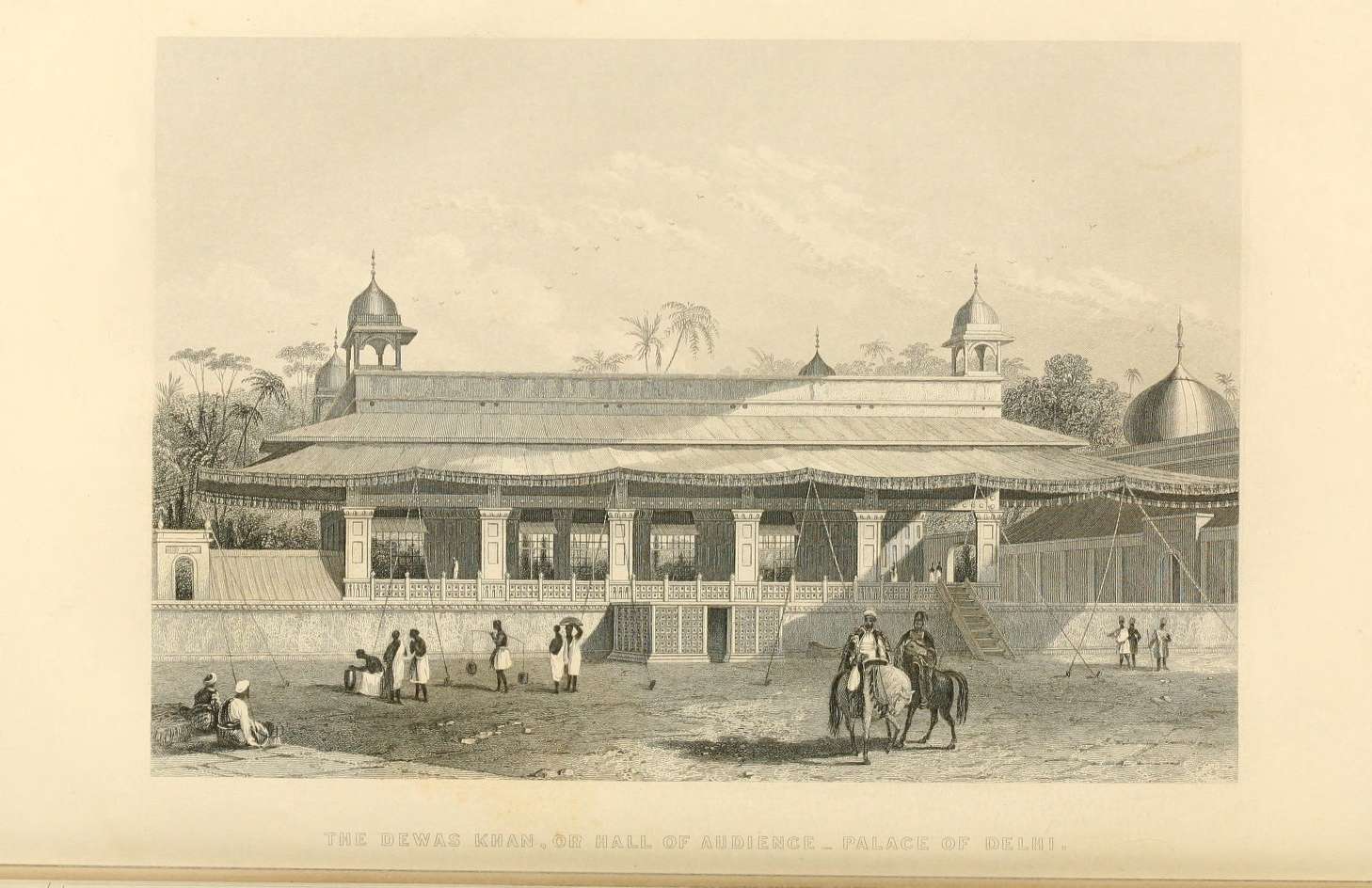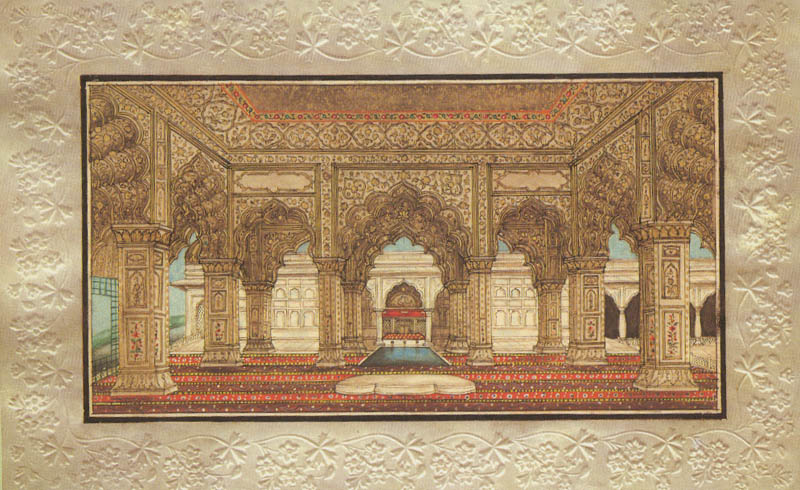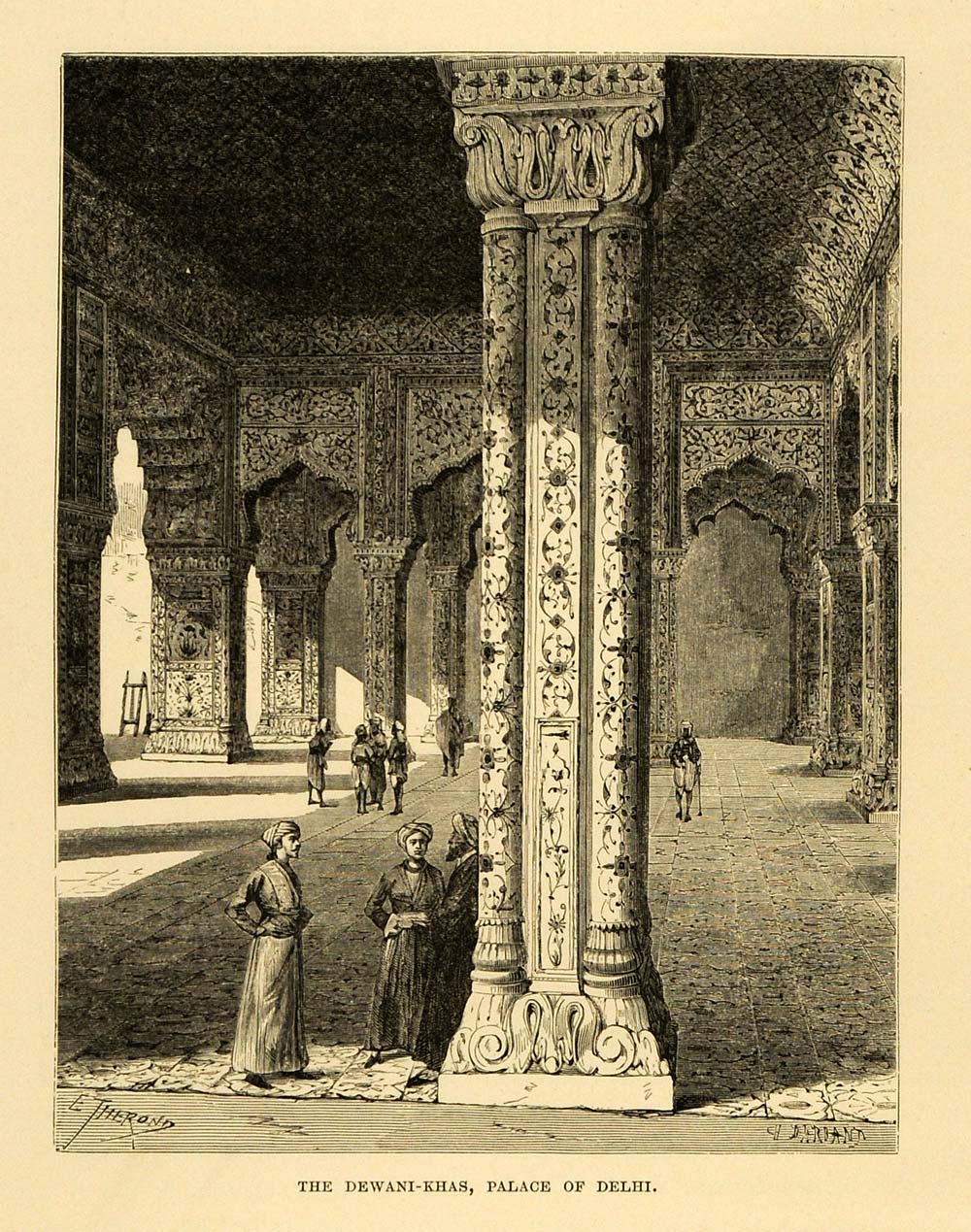

*The Diwan-i-Khas or Hall of Private Audience, Delhi; a watercolor, c.1815* (BL)

*The Divan-i Khass in the Palace in the Delhi
Fort; a watercolor by Ghulam Ali Khan, 1817* (BL); *a very large scan of this
engraving*
Source: ebay, Feb. 2011
*Diwan-i Khas, Red Fort, Delhi; a watercolor, 1823* (BL) [*watercolor 1823*]

The Divan-e Khas (Hall of Private Audience) in the Red Fort, Delhi, c.1840's
Source: The Golden Calm: An English Lady's Life in Moghul Delhi (Reminiscences by Emily, Lady Clive Bayley, and by her father, Sir Thomas Metcalfe), ed. M. M. Kaye (New York: Viking Press, 1980), p. 46; scan by FWP, Sept. 2001
"The Dewan-e-Khass or Audience Hall for the Nobility, was constructed by the Emperor Shah Juhan, by whom the Royal Palace was also built. It is situated at the upper end of a spacious Square, elevated upon a Terrace of White Marble about four Feet in height. The Dewan-e Khass in former times was adorned with excessive magnificence, and though plundered by Nadir Shah, the King of Persia during his invasion in 1783/9, and subsequently Mutilated by the Barbarous Hordes of Mahrattas during the latter end of the past and beginning of the present Century, still retains sufficient Beauty to render it the object of Admiration....In the interior of the Building and in the cornice are the following lines written in the Persian Character in letters of Gold: Ugur Firdoce bur Roo-e Zumeen ust. Humeen ust o Humeen ust o Humeen ust.* If there be a Paradise upon Earth. It is this, it is this, it is this." (caption by Sir Thomas Metcalfe, c. 1840's, p. 46)
*[agar firdaus bar-ruu-i zamiin ast / hamiin ast o hamiin ast o hamiin ast]
*"The Dewas Khan, or Hall of Audience, Palace of Delhi," from vol. 3 of 'The Indian Empire' by Robert Montgomery Martin, c.1860*
Source: http://www.archive.org/details/indianempirehist03martuoft
(downloaded Jan. 2009)


A colored lithograph of the Divan-e Khas, 1887
Source: ebay, Nov. 2003
The inner room of the hall is formed by twelve pillars; it is 48 feet long and 27 feet wide, and here may yet be seen the square marble platform on which stood the world-renowned Peacock Throne of Shah Jahan. Under the cornice of this room, and directly over the corner arches of the narrow sides, in small oblong panels, may be seen the famous inscription of Saad-ullah Khan, supposed to be in the hand-writing of Rashid, the greatest calligraphist of his time.... If there is a paradise on earth, it is this, it is this, it is this....
The Peacock Throne was broken up and all that was of value in it was taken away by Nadir Shah after his occupation of Delhi in 1739. Bernier, who saw the throne in the reign of Aurangzeb, thus describes it, and the festive occasions when it was displayed to the world:
The throne was supported by six massy feet, said to be of solid gold, sprinkled over with rubies, emeralds, and diamonds. I cannot tell you with accuracy the number or value of this vast collection of precious stones, because no person may approach sufficiently near to reckon them.... The construction and workmanship of the throne are not correspondent with the materials; but two peacocks, covered with jewels and pearls, are well conceived and executed. They were made by a workman [Austin de Bordeaux] of astonishing powers, a Frenchman by birth, who after defrauding several of the Princes of Europe, by means of false gems, which he fabricated with peculiar skill, sought refuge in the great Mogul's court, where he made his fortune. At the foot of the throne were assembled all the Omrahs in splendid apparel upon an estrade surrounded by a silver railing and covered by a spacious canopy of brocade with deep fringes of gold. The pillars of the hall were hung with brocades of a gold ground and flowered satin; canopies were raised over the whole expanse of the extensive apartment, fastened with red silken cords, from which were suspended large tassels of silk and gold. The floor was covered entirely with carpets of the richest silk, of immense length and breadth. A tent, called the aspek, was pitched outside, larger than the hall, to which it joined by the top. It spread over half the court, and was completely enclosed by a great balustrade covered with plates of silver. Its supporters were pillars overlaid with silver, three of which were as thick and as high as the mast of a barque, the others smaller. The outside of this magnificent tent was red, and the inside lined with elegant Masulipatam chintzes, figured expressly for that very purpose with flowers so natural and colours so vivid that the tent seemed to be encompassed with real parterres.--Carr Stephen, Archaeology and Monumental Remains of Delhi (Author, 1876), pp. 228-30
THE PEACOCK THRONE ACCORDING TO JEAN-BAPTISTE TAVERNIER, 1631:
It should be stated that the Great Mogul has seven magnificent thrones, one wholly covered with diamonds, the others with rubies, emeralds, or pearls.
The principal throne, which is placed in the hall of the first court, is nearly of the form and size of our camp-beds; that is to say, it is about 6 feet long and 4 feet wide. Upon the four feet, which are very massive and from 20 to 25 inches high, are fixed the four bars which support the base of the throne, and upon these bars are ranged twelve columns, which sustain the canopy on three sides, there not being any on that which faces the court. Both the feet and the bars, which are more than 18 inches long, are covered with gold inlaid and enriched with numerous diamonds, rubies, and emeralds.
In the middle of each bar there is a large balass ruby, cut en cabuchon, with four emeralds round it, which form a square cross. Next in succession, from one side to the other along the length of the bars there are similar crosses, arranged so that in one the ruby is in the middle of four emeralds, and in another the emerald is in the middle and four balass rubies surround it. The emeralds are table-cut, and the intervals between the rubies and emeralds are covered with diamonds, the largest of which do not exceed 10 to 12 carats in weight, all being showy stones, but very flat.
There are also in some parts pearls set in gold, and upon one of the longer sides of the throne there are four steps to ascend it. Of the three cushions or pillows which are upon the throne, that which is placed behind the King's back is large and round like one of our bolsters, and the two others that are placed at his sides are flat. There is to be seen, moreover, a sword suspended from this throne, a mace, a round shield, a bow and quiver with arrows; and all these weapons, as also the cushion and steps, both of this throne and the other six, are covered over with stones which match those with which each of the thrones is respectively enriched.
I counted the large balass rubies on the great throne, and there are about 108, all cabuchons, the least of which weighs 100 carats, but there are some which weigh apparently 200 and more. As for the emeralds, there are plenty of good colour, but they have many flaws; the largest may weigh 60 carats and the least 30 carats. I counted about 116; thus there are more emeralds than rubies.
The underside of the canopy is covered with diamonds and pearls, with a fringe of pearls all round, and above the canopy, which is a quadrangular-shaped dome, there is to be seen a peacock with elevated tail made of blue sapphires and other coloured stones, the body being of gold inlaid with precious stones, having a large ruby in front of the breast, from whence hangs a pear-shaped pearl of 50 carats or thereabouts, and of a somewhat yellow water. On both sides of the peacock there is a large bouquet of the same height as the bird, and consisting of many kinds of flowers made of gold inlaid with precious stones. On the side of the throne which is opposite the court there is to be seen a jewel consisting of a diamond of from 80 to 90 carats weight, with rubies and emeralds round it, and when the King is seated he has this jewel in full view.
But that which in my opinion is the most costly thing about this magnificent throne is, that the twelve columns supporting the canopy are surrounded with beautiful rows of pearls, which are round and of fine water, and weigh from 6 to 10 carats each. At 4 feet distance from the throne there are fixed, on either side, two umbrellas, the sticks of which for 7 or 8 feet in height are covered with diamonds, rubies, and pearls. The umbrellas are of red velvet, and are embroidered and fringed all round with pearls.
That is what I have been able to observe regarding this famous
throne.... and those who keep the accounts of the King's jewels,
and of what this great work has cost, have assured me that it
amounts to 107,000 lakhs of rupees....
--H. K. Kaul, ed., Historic Delhi: An Anthology (New Delhi: Oxford University Press, 1985), pp. 345-346
== Indian Routes index == Indian Routes sitemap == Glossary == FWP's main page ==